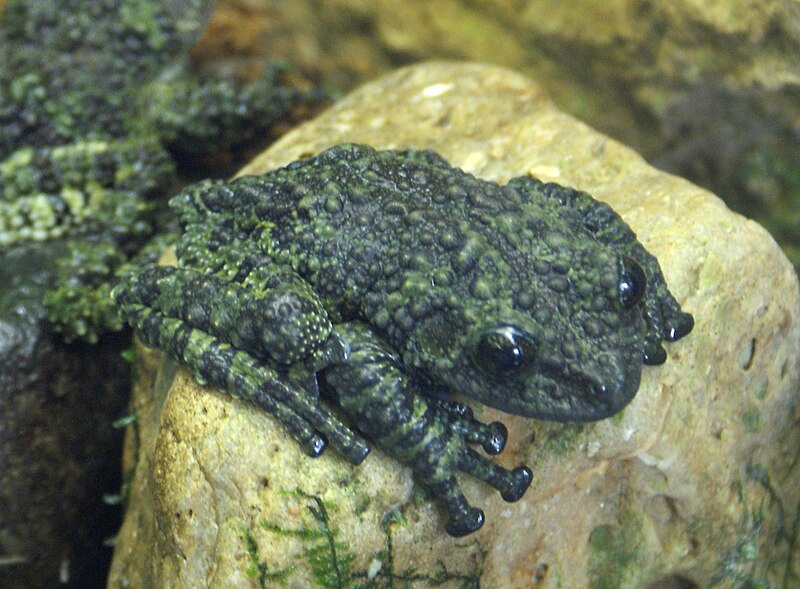 This article is one of a series in which I plan to provide a brief introduction to both popular and rarely-kept species. I’ll cover such topics as unique habits, common husbandry concerns and little-known tips, pet pros and cons, and so forth. Detailed care articles will follow…until then, I would enjoy receiving your questions and comments. Today we’ll take a look at the Mossy Treefrog or Tonkin Bug-Eyed Frog, Theloderma corticale.
This article is one of a series in which I plan to provide a brief introduction to both popular and rarely-kept species. I’ll cover such topics as unique habits, common husbandry concerns and little-known tips, pet pros and cons, and so forth. Detailed care articles will follow…until then, I would enjoy receiving your questions and comments. Today we’ll take a look at the Mossy Treefrog or Tonkin Bug-Eyed Frog, Theloderma corticale.
Ultimate Camouflage Artists
Mossy Treefrogs made quite a splash in the zoo world when they began showing up about 10 years ago. I was fortunately able to work with some of the first specimens to arrive here, and was immediately taken in by them.
While effective camouflage was not new to me – I had long marveled at Gaboon Vipers, Leaf Insects and other masters – the Mossy Frogs topped all I had seen. Installed in an exhibit with moss and lichen covered rocks, they were nearly impossible to locate. Even when I found one perched in full view, and stared directly at it, the animal’s complete outline was hard to discern. Not only color (a complex blend of green, greenish-blues and black) but also texture contributes to the startling effect. Their numerous spines, bumps and areas of raised skin render them indistinguishable from a clump of moss.
I have experimented a bit with captive habitats, and have found that they unfailingly choose to rest either on moss or, if denied such, at the water’s edge, in a cranny, where moss “should be”.
Natural History
 Mossy Treefrogs and 16 related species are classified within the Family Rhacophoridae. They are known only from steep slopes in northern Vietnam, but the difficulty in finding them suggests that they may have a wider range. They seem limited in habitat to caves and the nooks and crannies in cliffs along streams; however, they have also been found in the flooded basement of an abandoned building and in outdoor wells (please see article below).
Mossy Treefrogs and 16 related species are classified within the Family Rhacophoridae. They are known only from steep slopes in northern Vietnam, but the difficulty in finding them suggests that they may have a wider range. They seem limited in habitat to caves and the nooks and crannies in cliffs along streams; however, they have also been found in the flooded basement of an abandoned building and in outdoor wells (please see article below).
Care
In general, Mossy Treefrog care follows that of other semi-tropical treefrogs. One important point to bear in mind is the need for dietary variety. As we know nothing of the composition of their natural diet or the need for vitamin supplementation, providing such seems to serve as “insurance”. Mine accepted crickets, but showed a marked rise in interest level when offered moths, houseflies, smooth caterpillars, roaches, harvestmen and other wild caught invertebrates.
As with other small treefrogs, I also believe that small food items (i.e. to the size of a half-grown cricket) should comprise the bulk of the diet and that soft-bodied species should dominate.
 Mossy treefrogs are strictly nocturnal, but a night-viewing bulb will assist you in observing their behavior.
Mossy treefrogs are strictly nocturnal, but a night-viewing bulb will assist you in observing their behavior.
Captive breeding is not regular; those I cared for were kept at a relatively stable temperature and did not reproduce. Based on the article linked below, and on the fact that they experience cool temperatures (40 F or so) in the wild, a period of reduced temperatures is likely a necessary prelude to breeding.
Further Reading
Excellent International Zoo News Article: field observations and captive breeding.
American Museum of Natural History review of all species in the genus Theloderma.
Mossy Tree Frog blending image referenced from wikipedia and originally posted by Steven G. Johnson
 That Reptile Blog – Reptile, Amphibian and Exotic Pet Care and Information
That Reptile Blog – Reptile, Amphibian and Exotic Pet Care and Information


